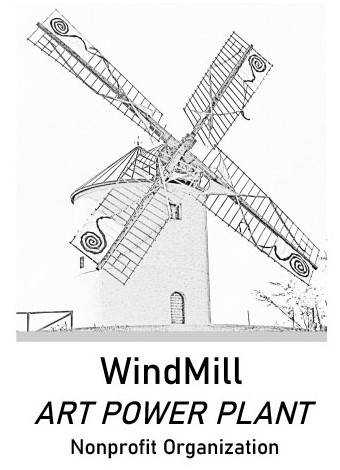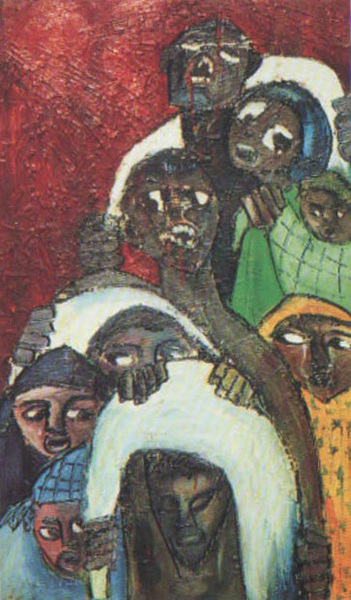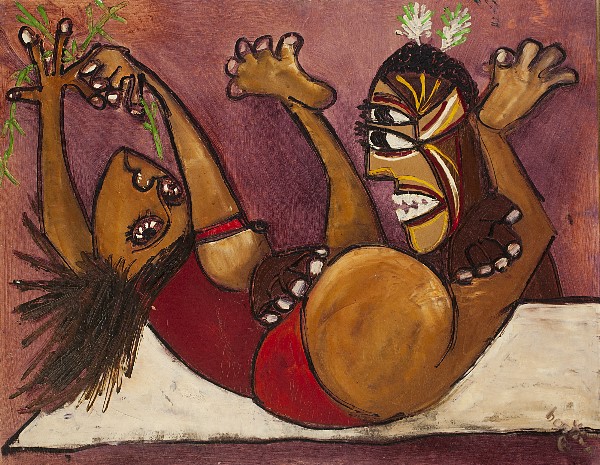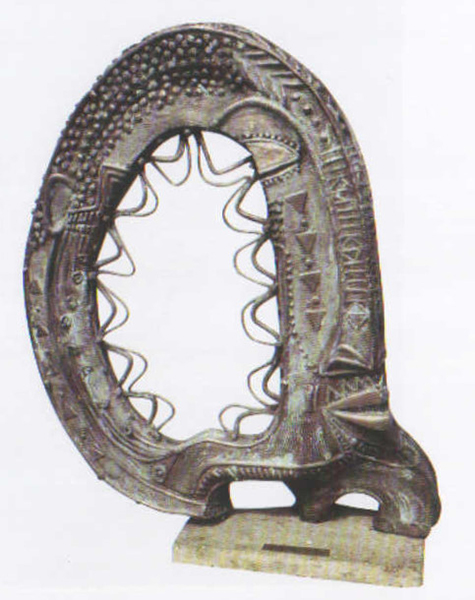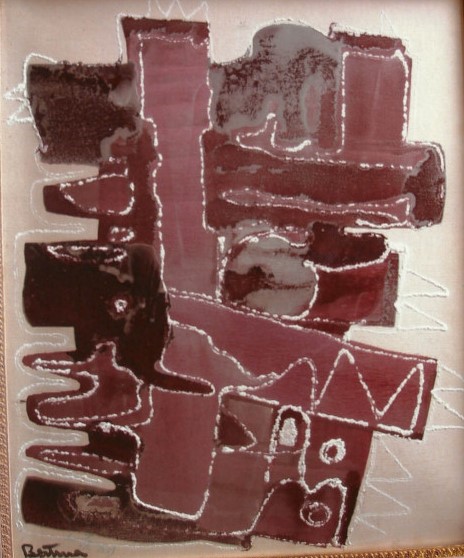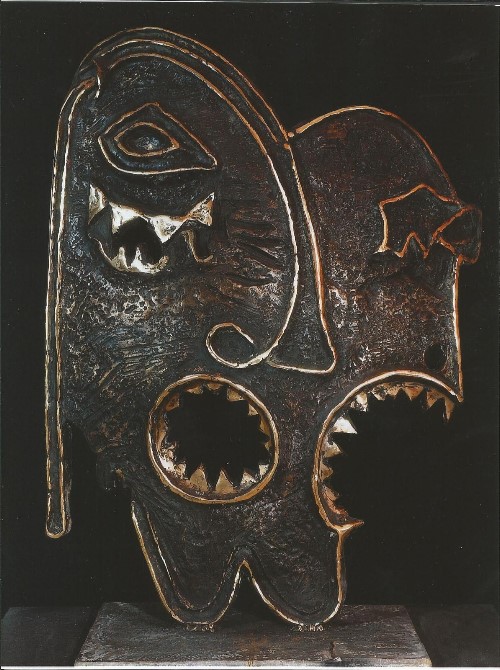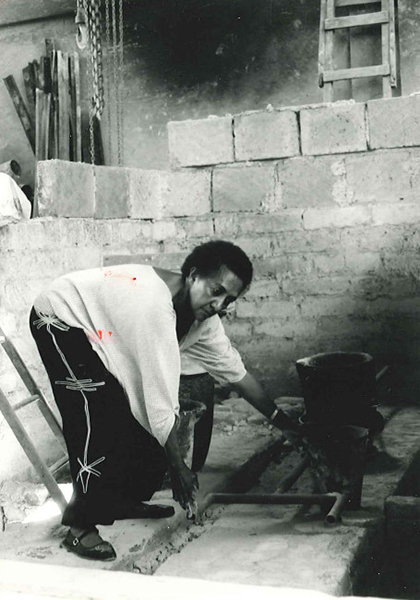
Biography
Bertina Lopes was a world famous artist. She was born on July 11, 1924, in Maputo, formerly Lourenço Marques, the capital city of Mozambique. Her mother belonged to a distinguished local family, while her father was a Portuguese colonist who worked in the field of commerce.
The artist and her three sisters received a strict scholastic education. At the same time, her dynamic family environment stimulated her precocious artistic disposition and her sense of justice and freedom that influenced her personal, ideal and artistic choices.
She attended school in Maputo, but, after her second year of senior high school, she moved to Lisbon to complete the secondary school. Here she began to study painting and drawing with Lino António and Celestino Alves. Between 1945 and 1949, she attended a course in “Desenhador Litógrafo e Pintura Decorativa” (Litograph design and decorative painting) at “Escola de Artes Decorativas António Arroio” (“António Arroio School of Decorative Arts”), where she got a degree and an Arts Teacher Training. She also attended a painting course at “Escola Superior de Belas-Artes de Lisboa” (“University of Arts of Lisbon”).
In Lisbon, she got in contact with famous painters and intellectuals of the period, like Carlo Botelho, Albertina Mantua, Costa Pinheiro, Júlio Pomar and Nuno Sampayo. During that period, Bertina was mainly influenced by Avant-garde painting of Portuguese Modernism. The art exhibitions of important western painters and South American graffiti artists, organized by the National Society of Fine Arts (1946-56), deeply influenced the artistic background of Bertina Lopes and the other young artists of the period. During those days, the cultural and artistic atmosphere in Portugal was afflicted by the suffocating narrow-mindedness of Antonio Salazar’s government that affected in particular the production of “arte negra” (black art).
In that atmosphere, Bertina joined antifascist circles.
These political circles were inspired by Marxist and liberal ideals. There, she met many political leaders of the clandestine opposition and she incubated a strong feeling of freedom and democracy. She openly declared her communist inclinations and so the secret police kept her under strict control. In 1953 she returned to Mozambique where she taught “Artistic Drawing” at “General Machado Girls’ Technical School” for nine years. She also taught “Artistic Drawing” and “Decorative Painting” at African Association center.
She was very popular among students for her innovative teaching, based on the observation of urban, social and natural environment, and for the feeling of freedom of her aesthetic and political ideas, but her teaching came into conflict with the strict school rules. In 1956 she made a mural painting into the “Pavilhão da Evocação Històrica” of the “Exposiçao de Actividades Sociais, Culturais e Economicas”, opened in conjunction with the visit in Mozambique of general Craveiro Lopes, President of the Republic of Portugal.
In 1959 she was nominated President of the “Secção des Artes Plàsticas” of “Nùcleo de Arte” of Maputo. She was also nominated Vice President of “Direccao” of “Nùcleo de Arte” in 1960. In that period the artist had some political problems. In those years, Lopes met the most important protagonists of Mozambican anticolonial fight, such as Edoardo Mondane, founder of FRELIMO (Frente de Liberaçao do Moçambique), and Samora Machel, that was going to be the President of the Republic of Mozambique. She also met a lot of important artists and intellectuals that were going to play a key role in the future of Mozambique.
In those days, Bertina began to be interested in poetry. She especially liked Noémia de Sousa and José Craveirinha that influenced her artistic sensibility and her ideal motivations. She married Virgilio de Lemos (Ibo, 1929), one of the most important poets of Mozambique. In 1955 they had two twin sons, Virgilio and Eugenio. During those years, de Lemos published, under the heteronym of Duarte Galvão, an anticolonial poem that caused him a trial for desecration of the Portuguese flag (1954). After that, he joined the Mozambican Resistance (1954-61). He was also accused and arrested for “subversion” and for his collaboration with the clandestine groups that fought for the independence of Mozambique.
The influence of her husband and of her friends strengthened Bertina’s political believes on people’s liberation from colonial oppression and from racial, social and cultural discrimination. These ideas were connected with the colonial invasion of Africa that caused exploitation and pains. She also felt an innate spirit of sympathy with the humble, the oppressed and the weak that are the subjects of a lot of her artworks of that period. In 1961, she was forced to leave Mozambique and so she returned to Portugal where she could live and paint thanks to Victor de Sa Machado, head of Calouste Gulbenkian Foundation in Lisbon, who gave her a scholarship. In 1962 her two sons joined her and they moved to Cascais, while her husband escaped from Mozambique and hardly reached Paris.
From a stylistic point of view, Lopes’ artworks of that period are characterized by a strong ethnical sensibility that was going to return in her Roman years (1960s-1970s), while the subjects are based on African fairy-tales and stories, José Craveirinha’s poems and the political and social events of that period. During the years of her voluntary exile these subjects represented new expressive mythologies and a cry of opposition and action toward independence. In Lisbon she met Manuel de Brito, head of Galeria III, who introduced her to a lot of artists and intellectuals. He also helped her examine the stylistic and conceptual novelties of avant-garde painting. As a matter of fact, from a visual point of view Bertina’s figuration was more and more influenced by avant-gardes that she developed through a daring employment of color and a use of line completely influenced by post-cubist deconstructivism.
These two elements represent a fil rouge upon which Lopes built her artistic catalogue. In 1963 Bertina began to make pottery with Querumbin Lapa at Fábrica Viùva Lamego (Lisbon). During the same periond she obtained another Gulbenkian Foundation scholarship and she left Portugal where was impossible to live for a free female artist like her. Bertina moved to Rome (1964) to escape the control of the Portuguese political police and to complete and refine her artistic background.
Here she married Francesco Confaloni, an art and music lover, in 1965 and she achieved Italian citizenship. In that period she met some Italian artists and started to confront her personal and original artistic language with them. Among these artists there were Marcello Avenali, Franco Gentilini, Emilio Greco, Lorenzo Guerrini, Marino Marini and Antonio Scordia. Lopes dedicated a painting to the death of the last one (1988). She also got on very well with Carlo Levi and had a complex relationship with Renato Guttuso.
She was also associated with intellectuals and art critics who followed and supported her artistic career, such as Giulio Carlo Argan, Dario Micacchi, Nello Ponente, Marcello Venturoli, and, during the 1970s-1980s, Enrico Crispolti, Simonetta Lux, Renato Nicolini, Carlo Savini, Luciana Stegagno Picchio, Claudio Strinati and many others. Without forgetting her strong cultural relationship with Enrico Berlinguer. In Rome Bertina Lopes stressed the expressive profundity of her figuration. She entitled “La mia radice antica” (My ancient root) a set of artworks she made during the 1970s-1980s. These works of art showed the reflexive and nostalgic character of her “personal look toward the past” that typified her painting in that period.
In 1973 she moved to the U.S. for a short period and she visited New York, Washington, Boston, Philadelphia and their museums of contemporary art.
In this way she could increase her knowledge of avant-gardes and post avant-gardes. She was influenced by the post-cubist painting of Georges Braque, the syncopated linearity of Henri Matisse and the art of Pablo Picasso that she considered the “genius of the 20th century” and that she used to confront the gradual improvement of her personal and original pictorial style. Bertina met Picasso, during the last days of his life, thanks to their mutual friend Juana Mordò, a gallery manager from Madrid. As a consequence of this intense and fundamental encounter, Bertina made in 1974 one of her most important and intense paintings to pay homage to the death of Picasso (1973),
“Omaggio per la morte di Picasso” (Tribute to the death of Picasso). This artwork is deliberately based on “Guernica”’s style, but she strengthened its sense of distress, claustrophobia and tragicalness. The “father of world pictorial avant-garde” is depicted in silhouette, colored grey-green – the death/immortality of commemorative monuments – with two ears and two eyes for each side to allude to the sensorial strenght of the artist. Aloft, next to the “genius” there is the Minotaur, a subject that is strictly connected with Picasso, surrounded by crying women and soldiers that symbolizes the political repression that Picasso fought in Spain. This artwork is the paradigm and the summa of Lopes’ painting during the 1970s.
Bertina was still deeply connected with Mozambique and Portugal, where her sisters and sons lived. This link was strengthened after the Carnation Revolution, ended on 25 April 1974 with the return of democracy in Portugal. The Third Portuguese Republic gave independence to Portugal’s African possessions in 1975. More than a million African-Portuguese people left the colonies, while in Mozambique started a series of civil wars that were going to last almost 30 years. Lopes’ painting was deeply influenced by the political events that struck her country, in particular during the period that followed the independence, in which there was a civil war between two Mozambican nationalist groups, FRELIMO and RENAMO (Resistencia Nacional Moçambicana).
Under the presidency of Samora Machel, leader of FRELIMO, Mozambique launched a project of socialist economy that promoted the other African nationalist movements such as the African National Congress of South Africa. This political alignment cost to Mozambique the hostility of the white governments of South Africa and Rhodesia and of the USA. These countries were among the main financial backers of RENAMO, an anti-communist armed group against the new President. During the 1980s RENAMO dragged Mozambique in a new civil war that caused human, humanitarian and economic disastrous consequences. This civil war deeply affected Bertina Lopes. Her paintings of that period are characterized by a violent chromatic impact, a search for new materials that she used to express an explicit and political break, denunciation and protest. Her “Totems” made on ropes, papers and fragments of wood are cultural and visual emblems of her motherland, felt as too closed in its political microcosm and manipulated by the main western powers.
Giulio Carlo Argan admired these artworks and he sustained, as art historian and mayor of Rome (1976-79), that the art of Lopes was one of the most congenial expressions to consider Rome as “communis patria” of every art form and culture. In 1977 he invited her to display her artworks at “Rome Quadriennale”, hosted by “Palazzo delle Esposizioni”.
In 1979 the Republic of Mozambique granted her the citizenship. In the early 1980s, Lopes started to make a series of bronzes. These bronzes have a totem shape and represent a visual metaphor of violence.
In 1981 she signed a contract with “Fortunato Silvério’s” factory in Porto to produce wall paper. In the same year she was officially invited by Samora Machel, President of Mozambique, to take part in the celebration for the Sixth Anniversary of Mozambique’s Independence. In 1981 Lopes was also invited by the Culture Minister of Iraq to exhibit her artworks in the National Museum of Modern Art of Baghdad. In 1982, an important show of Bertina Lopes’ painting took place at “Museu Nacional de Arte Moderna” in Maputo. That exhibition represented the official acknowledgement for the work she had made in Europe. We also have to mention the exhibition of her new bronzes and latest paintings that took place in Luanda, Angola, and the anthological exhibition that took place at Palazzo Venezia, in Rome, in 1986.
During the late 1980s and the early 1990s, Bertina Lopes paid attention to the Cosmos, the Space. During the early 1990s she made artworks focused on recreate a personal, colorful Cosmogonic reality characterized by astral intersections, planetary joints and encounters, and a series of signs in which her African roots are still evident. In that way, Lopes detached herself from the social idea of everyday life and at the same time joined the new theories of the end of millennium. Lopes’ silent and tireless intermediation aided to achieve the Rome General Peace Accords, signed in Rome on October 4, 1992, between the Government of Mozambique and the opponents of RENAMO.
The peace accords were reached through a long mediation activity – 27 months and 11 work sessions – managed by the United Nations, the Community of Sant’Egidio (represented by Andrea Riccardi and Matteo Zuppi), Bishop Jaime Gonçalves and the Italian Government. Andrea Riccardi, who was going to become Minister of International Cooperation of Italian Government in 2011, prefaced the peace accords: “This home, (…) opens during these days as a Mozambican home for Mozambican people (…). We know that we are meeting Mozambican patriots, really Africans, without intercession. Each of you has deep roots in Mozambique. Mozambique is your history. Mozambique is your future. We are here to host a truly Mozambican event, a truly Mozambican meeting. Our presence here is intended to be strong as far as friendship is concerned but moderate and respectful at the same time”.
In 1993, in Lisbon, Lopes was nominated “Commander of Arts” by the President of the Republic of Portugal, Mario Soares. That same year she became Cultural Counsellor at Mozambique Embassy in Italy. This was an important acknowledgement for a person that had always helped and organized cultural and artistic initiatives to support her motherland.
During her long lasting artistic career Bertina realized a lot of exhibitions, hosted by prestigious sites, both in Italy and abroad, while she received a lot of awards for her human and artistic engagement, such as the “Grand Prix d’Honnoeur” (1988), assigned by European Union of Arts Critics, and the “Carson” World Prize (1991), assigned by Rachel Carson Memorial Foundation of New York.
In 1996, at the World Food Summit, FAO organized a thematic exhibition of Bertina Lopes’ artworks. It was the first international exhibition hosted by FAO World Centre in Rome. In 1998 Graça, widow of General Samora Machel, died in 1986 in a controversial air crash, introduced Bertina Lopes to her new husband, Nelson Mandela, South African anti-apartheid leader and winner of a Nobel Peace Prize. Between the late 1990s and the beginning of the 21th century, Bertina Lopes’ painting was characterized by the absence of paintbrush and a greater concentration of colour. She also used industrial materials.
Lopes’ last paintings are founded on the guided, and sometimes violent, pouring of colour on canvas. Her big artworks are now composed of clots and stripes of colour. The spots are quite psychedelic and kaleidoscopic. This new artistic theme is highly represented in a new series of paintings (2000-2002) characterized by a rhythmic mark: the colour follows a rhythm, but there is also the influence of jazz music that Lopes had already used in the early 1990s, when she was approaching to Kandinskij’s theories on spiritual and musical colour.
In 2002, after a great anthological exhibition hosted by “Palazzo della Cancelleria Apostolica” in Rome, under Pontifical Commission for the Cultural Heritage of the Church’s protection, the President of the Republic of Italy presented to Bertina Lopes the Silver Plaque, one of the most important Italian acknowledgements in the cultural, artistic and intellectual field. This exhibition was organized with the help of Consiglio Italiano per i Rifugiati (Italian Council for Refugees) and it was dedicated to people who was forced to exile a cause of war, persecution and encroachment on human rights. In 2006 the Ministry of Cultural Heritage and Activities organized another great thematic exhibition about Lopes’ art at “Museo della Città di Rimini” (Rimini) and at “Central Archives of the State” in Rome. On that occasion Carlo Azeglio Ciampi, President of the Republic of Italy, issued an augural greeting “with a lively appreciation of the cultural value of the event”.
Bertina Lopes died in Rome on 10 February 2012. The same year her husband Francesco Confaloni started to collect a first paper and web documentary nucleus of Bertina Lopes’ Archives to collect and reorganize her artistic material.
Lopes’ artworks are hosted by many private and public collections, both in Italy and abroad. Among the most important there are: Baghdad (Iraq), National Museum of Modern Art; Castelfranco Veneto (Treviso), Palazzo Comunale; Jeddah (Saudi Arabia), National Museum of Modern Art; Saint Gabriel (Teramo), Stauros Museum of Holy Contemporary Art; Lisbon (Portugal), Museo de Fundaçao Calouste Gulbenkian; Lisbon (Portugal), Mario Soares Foundation; Maputo (Mozambique), National Museum of Modern Art; Orvieto (Terni), Palazzo Comunale; Rome, Central Archives of the State; Rome, FAO World Center; Varese, Civic Museum; Capua (Caserta), Museo Campano.
Awards
1950 – Painting Prize, Lourenço Marques (Mozambique)
1953 – Medalha de Prata, Lourenço Marques (Mozambique)
1953 – Prémio Empresa Moderna, Lda., Lourenço Marques (Mozambique)
1958 – First Classified (Maior Mérito Artistico), Beira (Mozambique)
1974 – “Trullo D’Oro”, Fasano di Puglia (Brindisi)
1974 – “La Mamma nell’arte. Comunità di Sant’Egidio”, Rome
1975 – International Painting Prize “International Center of Mediterranean Art and Culture”, Corfu (Greece)
1978 – “Leader d’arte. Campidoglio”, Rome
1986 – Venere d’Argento, Erice, (Trapani)
1988 – “Grand Prix d’Honnoeur”, European Union of Art Critics, Rome
1991 – “Rachel Carson Memorial Foundation” World Prize, Rome
1992 – “La Plejade per l’Arte”, Rome
1993 – “Commander for Merits”, appointed by Mario Soares, President of the Republic of Portugal, Lisbon (Portugal)
1994 – “Centro Francescano Internazionale di Studi per il dialogo fra i popoli” (Franciscan International Study Center to promote dialogue among people), Assisi (Perugia)
1995 – “Gabriele D’Annunzio Prize”, Pescara
1996 – “Messaggero della Pace UNIPAX” Prize, Rome
1998 – “Premio Internazionale Arte e Solidarietà nell’Arca”, Florence
1998 – “Frà Angelico”, International Prize, Rome
2002 – Silver Plaque by the President of the Republic of Italy
Curriculum
1957
Salão de Exposições do Edificio dos Organismos de Coordenação Econòmica, Nùcleo de Arte, Lourenço Marques (Mozambico).
1958
Galeria Poliarte, Lourenço Marques (Mozambico).
Salão do Edifìcio dos Organismos de Coordenação Economica, Casa da Metròpole, Lourenço Marques (Mozambico).
Salão Nobre da Cãmara Municipal da Beira, Beira (Mozambico).
1959
Galeria de Arte A.E., Beira (Mozambico).
Galeria de Diàrio de Notìcias, Lisbona (Portogallo).
Salão de Arte Moderna, Secretariado Nacional de Informação, Lisbona (Portogallo).
Salão de Artistas Independentes, Lisbona (Portogallo).
1960
Galeria Poliarte, Lourenço Marques (Mozambico).
Salão Nobre de Cãmara Municipal, Beira (Mozambico).
Prédio Montalto, Vila Pery – attuale Chimoio (Mozambico).
1961
Salão do Edificio dos Organismos de Coordenação Econòmicas, Nucleo de Arte, Lourenço Marques (Mozambico).
1962
Salão do Edificio das Associaçoes Econòmicas, Lourenço Marques (Mozambico).
1963
Galeria Divulgação, Porto (Portogallo).
1964
Sociedade Nacional de Belas Artes, Lisbona (Portogallo).
1970
Galleria Astrolabio, Roma.
1971
Studio d’Arte Hermes, Roma.
1972
Museo de Fundação Calouste Gulbenkian, Lisbona (Portogallo).
1973
Galeria Alvarez, Porto (Portogallo).
1974
Galleria Artivisive, Roma.
Galeria Alvarez, Porto (Portogallo).
1975
Galleria Numero, Venezia.
Centro Congressi del Garda a Villa Alba, Gardone Riviera (Brescia).
Museo del Giorgione, Castelfranco Veneto (Treviso).
1976
Biblioteca Comunale “A. Sebatino”, Chioggia (Venezia).
Galeria Juana Mordò, Madrid (Spagna).
1977
Galleria La Leonessa, Brescia.
Palazzo delle Esposizioni (X Quadriennale Nazionale d’Arte. Artisti stranieri operanti in Italia), Roma
1978
Centro Falesia, Piombino (Livorno).
Centro Skema, Roma.
Palazzo La Loggia, Motta di Livenza (Treviso).
Galerie Leonardo da Vinci, Lussemburgo.
1979
Galleria Lombardi, Roma.
1981
Museo Nazionale d’Arte Moderna, Bagdad (Iraq).
1982
Museu Nacional de Arte Moderna, Maputo (Mozambico).
1983
Casino Estoril, Estoril (Portogallo).
Museo Nazionale di Storia, Luanda (Angola).
1985
Palàcio da Asembleia Popular, Praia (Capo Verde).
1986
Palazzo Venezia, Roma.
1988
Palazzo dei Congressi, V Festival Internazionale del Film Turistico, Montecatini Terme (Pistoia).
1993
Museo de Fundação Pro-Moçambique, Lisbona (Portogallo).
Giardini di Castel Sant’Angelo, Roma / Antinoo Caffè Moda, Roma.
1994
Centro Cultural Portoguês, Praia, Mindelo (Capo Verde).
1994/1995
Museo Nazionale di Arte, Maputo (Mozambico).
1995
Centro Culturale Italiano, Gedda (Arabia Saudita).
1996
Sede mondiale della FAO, Roma.
1997
Grand Hotel Palace, Varese.
1998
Palàcio da Asembleia Nacional, Praia (Capo Verde).
1999
Palazzo dei Sette, Orvieto (Terni).
2002
Teatro dell’Unione Femminile Nazionale, Milano.
Palazzo della Cancelleria Apostolica, Roma.
2003
Sala Giotto, Aeroporto Leonardo da Vinci, Fiumicino (Roma).
2004
Sala dei Marmi del Comune, Salerno.
2006
Museo della Città, Rimini / Archivio Centrale dello Stato, Roma.
2007
Museo Campano, Capua (Caserta).
Complesso Monumentale di Santa Sofia, Salerno.
2008
Fortezza da Basso, Firenze / Galleria Tartaglia Arte, Roma.
2012
Museu Nacional de Arte, Maputo (Mozambico).
Auditorium Parco della Musica, Foyer Petrassi, Roma.
Collettive
1950
I Salão de Artes Plàsticas, Salão do Edifìcio dos Organismos de Coordenação Econòmica, Casa da Metròpole, Lourenço Marques (Mozambico).
1952
IV Salão Anual de Artes Plàsticas de Moçambique, Salão do Edifìcio dos Organismos Econòmicos, Lourenço Marques (Mozambico).
1953
I Concurso Anual de Artes Plàsticas, Artistas de Moçambique, Salão de Exposiçoes dos Organismos de Coordenação Econòmica, Nùcleo de Arte, Lourenço Marques (Mozambico).
1956
Galeria Poliarte, Lourenço Marques (Mozambico).
Exposiçao da Vida e da Arte Portuguesas, Casa da Metròpole, Lourenço Marques (Mozambico).
Primerira Exposiçao de Claro/Escuro, Lisbona (Portogallo).
1957
I Salão Municipal, Festas da Cidade, Nùcleo de Arte, Lourenço Marques (Mozambico).
Galeria do Diàrio de Notìcias, Lisbona (Portogallo).
1958
Galeria Poliarte, Lourenço Marques (Mozambico).
II Salão de Artes Plãsticas, Edifìcio do Banco Nacional Ultramarino, Centro de Cultura e Arte da Beira, Beira (Mozambico).
II Exposiçao de Arte Moderna, Lisbona (Portogallo).
1959
Salão de Artes Plàsticas de Moçambique, Salão do Edifìcio dos Organismos de Coordenação Econòmica, Casa da Metròpole, Lourenço Marques (Mozambico).
1961
União Cultural, Recreativa e Desportiva Portuguesa, Nùcleo de Arte, Johannesburg (Sudafrica).
1962
II Exposiçao dos Artistas Independentes, Sociedade Nacional de Belas Artes, Lisbona (Portogallo).
1963
Pavilhão de Moçambique, Feira Industrial de Luanda, Luanda (Angola).
Salão do Edifìcio dos Organismos Econòmicos, Lourenço Marques (Mozambico).
Galeria Divulgação, Porto (Portogallo).
1970
Berlino (Germania).
Mosca (U.R.S.S.).
1972
Luanda (Angola).
Rosenthal Studio House, Roma.
1973
Crotone.
Casa Amarela, Lourenço Marques (Mozambico).
1974
Brindisi.
IKI – Internationaler Markt für aktuelle Kunst, Altes Messegelände, Düsseldorf (Germania).
Galleria Arti Visive, Roma.
Exposiçao Itinerante, Divulgação Cultural, Assocação Africana de Lourenço Marques (Mozambico).
1975
Centro Internazionale d’Arte Turismo e Cultura Mediterranea, Corfù (Grecia).
Galleria Astrolabio, Roma.
Inco Art ’75, Roma.
Galleria Fiamma Vigo, Roma.
Galleria La Ginestra, Sciacca (Agrigento).
Galleria Numero, Venezia.
1976
Arte Fiera di Bologna, Bologna.
Inco Art ’76, Bologna.
Museo di Sant’Egidio, Roma.
1977
Bottega d’Arte San Marco, Porto Santo Stefano (Grosseto).
Quadriennale d’Arte Nazionale di Roma, Palazzo delle Esposizioni, Roma.
1981
Artistas Moçambicanos, Mosca (U.R.S.S.).
Artistas Moçambicanos, Berlino (Germania).
1982
Artistas Moçambicanos, Luanda (Angola).
Artistas de Moçambique, Maputo (Mozambico).
Artistas de Moçambique, Beira (Mozambico).
Artistas de Moçambique, Nampula (Mozambico).
1983
Semana de Moçambique no Estoril, Casino Estoril, Estoril (Portogallo).
Royal Palace, Londra (Regno Unito).
1986
Segunda Bienal de Arte, Museo Nacional de Bellas Artes, Habana (Cuba).
Mozambico. Arte di un popolo, Palazzo Venezia, Roma.
1987
Mostra Cultural Moçambicana, Stoccolma (Svezia).
Mostra Cultural Moçambicana, Oslo (Norvegia).
Arte Na Empresa, Loja Galeria/Horizonte Arte-Diffusão, Maputo (Mozambico).
1988
L’Arte contro l’AIDS, Istituto San Michele, Roma.
1991
Bienal TDM91, Associação Moçambicana de Fotografia, Telecomunicações de Moçambique, Maputo (Mozambico).
1992
9 artistas de Moçambique. Exposição Universal Sevilha 1992, Pabellòn de las Artes, Siviglia (Spagna).
1993
Galleria Vicolo del Cinque, Roma.
1994
VI Biennale di Arte Sacra, Museo Staurós d’Arte Sacra Contemporanea, San Gabriele (Teramo).
Folgorati sulla via di Damasco, Chiostro del Convento di S. Onofrio al Gianicolo, Roma / Antinoo Caffè Moda, Roma .
1995
Aspectos da Arte Contemporanea Moçambicana, Centro Cultural Franco-Moçambicano, Maputo (Mozambico).
Incantesimi, scene di arte e poesia a Bomarzo, Palazzo Orsini, Bomarzo (Viterbo).
Fiumara Arte, Fiumara (Messina).
Helsinki (Finlandia)
1996
Africana, Galleria Sala 1, Roma.
1997
Diversity in contemporary African Art: causes & effects, Bricker Hall, Ohio State University, Ohio (U.S.A.).
1998
Artistas de Moçambique. Expo ’98, Museu da Electricidade em Lisboa, Lisbona (Portogallo).
1999
Ad libitum 99. Colectiva de artes plàsticas / pintores de lingua portuguesa, Galeria de Arte da Embaixada de Portugal, Brasilia (Brasile).
Il Sacro nell’arte contemporanea, Centro di Documentazione ricerca artistica contemporanea “Luigi di Sarro”, Roma.
2000
TransAfricana. Artisti contemporanei, Collezioni d’Arte e di Storia della Fondazione Cassa di Risparmio di Bologna, Bologna.
2001
L’uomo per la terra, Sede mondiale della FAO, Atrium, Roma.
Momentos vividos. Colectiva de artes plàsticas / pintores de lingua portuguesa, Centro Multi Meios, Espino (Portogallo).
2002
FAI. Le mostre all’Arca, Firenze.
2003
Kanimambo. Giornate mozambicane a Roma, Palazzo della Cancelleria Apostolica, Roma.
Movimondo. 30 anos de solidariedad e cooperação entre Moçambique e Itàlia, Centro Cultural Franco-Moçambicano, Maputo (Mozambico).
AfrItalia. Fuori luogo 2003, Chiesa di San Bartolomeo, Galleria Limiti Inchiusi, Campobasso.
Oro dei Castelli, Museo delle Scuderie di Palazzo Aldobrandini, Frascati (Roma).
Rosario. Preghiera prediletta, Istituto Antoniano, Roma.
2004
Come l’ombra. Inseparabilità di vita e ambiente in Marguerite Yourcenar, Archivio Centrale dello Stato, Roma.
L’Europa nel segno. Dieci artisti per l’Unione Europea, Galleria Pan, Genazzano (Roma).
2005
Imago Verba. Visioni e poetiche contemporanee, Galleria Tartaglia Arte, Roma.
Mediterraneo d’arte. Il mare e la pesca da Giorgio de Chirico all’era della globalizzazione, Archivio Centrale dello Stato, Roma / MAON, Museo d’Arte dell’Otto e Novecento, Rende (Cosenza).
Arte in piazza. Dentro/fuori/attraverso, Chiostro dell’ex Convento di San Michele, Guidonia Montecelio (Roma).
2006
In volo sopra il mondo, Vejano (Viterbo).
Dai grandi maestri alle giovani promesse, Galleria Tartaglia Arte, Roma.
2007
Le curve della mente, Museo Nazionale di Castel Sant’Angelo, Roma.
La Galleria presenta…, Galleria Tartaglia Arte, Roma.
Fiera “Immagina Arte”, Reggio Emilia.
La collezione Sylvia Franchi donata al Museo d’Arte Contemporanea di Caltagirone, Biennale della ceramica, Museo d’Arte Contemporanea, Caltagirone (Catania).
2008
José Craveirinha (1922-2003): Exposição de Peças do Acervo da Csa-Museu José Craveirinha, Nùcleo de Amigos José Craveirinha, Istituto Camões-Centro Cultural Portoguês, Maputo (Mozambico).
Repubblica e Costituzione, per i sessant’anni della Costituzione in Italia, Archivio Centrale dello Stato, Roma.
2009
La collezione d’arte contemporanea dell’Archivio Centrale dello Stato, Archivio Centrale dello Stato, Roma.
RURITALIA.it. Agricoltura e lavoro nell’arte del Novecento dal Futurismo a Facebook, Complesso dei Dioscuri al Quirinale, Roma.
HALIÉUS. Mare e pescatori nell’arte contemporanea, Palazzo dei Priori, Tarquinia (Viterbo).
2010
Sem Titulo: Um olhar sobre a Colecção de Arte Millenium BIM, Istituto Camões-Centro Cultural Portoguês, Maputo (Mozambico).
Tolstoj. Omaggio Tribute, Complesso dei Dioscuri al Quirinale, Roma.
Festival Internazionale d’Arte e Cultura Songzhuang, Galleria Italy Point, Pechino (Cina).
2011
ArteXpo, Arezzo.
2012
Le dee sono tornate, con un omaggio a Bertina Lopes, Castello dell’Abate, Belvedere San Costabile, Castellabate (Salerno).
Da Vedova a Rabarams. Opere degli ultimi quarant’anni, Galleria Tartaglia Arte, Roma.
ArteXpo, Arezzo.
2014
Europa Arte e Cultura, Palazzo dei Priori, Sala Sacchetti, Tarquinia.
Raccolta di Racconti. La collezione della galleria racconta la sua storia. VI edizione, Sala 1, Roma.
2015
Roma verso Expo, Complesso del Vittoriano, Ala Brasini, Roma.
Dalla tradizione all’innovazione: nutrire le vite, coltivare i sogni, Expo Mondiale 2015,
Padiglione del Mozambico, Milano.
Biennale di Venezia. Esposizione Internazionale d’Arte, Padiglione d’arte del Mozambico, Venezia.
EgosuperEgoalterEgo. Volto e corpo contemporaneo dell’arte, MACRO, Sale collezione, Roma.
La Prima Guerra Mondiale nell’arte contemporanea, Rocca dei Papi, Montefiascone.
2016
L’Altrove – Segno e Identità, Mediamuseum, Pescara.
Premi
1950 – Premio di Pittura, Lourenço Marques (Mozambico).
1953 – Medalha de Prata, Lourenço Marques (Mozambico).
1953 – Prémio Empresa Moderna, Lda., Lourenço Marques (Mozambico).
1958 – 1° Premio (Maior Mérito Artìstico), Beira (Mozambico).
1974 – “Trullo D’Oro”, Fasano di Puglia (Brindisi).
1974 – “La Mamma nell’arte. Comunità di Sant’Egidio”, Roma.
1975 – Premio Internazionale di Pittura “Centro Internazionale d’Arte e Cultura Mediterranea”, Corfù (Grecia).
1978 – “Leader d’Arte. Campidoglio”, Roma.
1986 – “Venere d’Argento”, Erice (Trapani).
1988 – “Grand Prix d’Honneur”, Unione Europea dei Critici d’Arte, Roma.
1991 – Premio Mondiale “Rachel Carson Memorial Foundation”, Roma.
1992 – “La Plejade per l’Arte”, Roma.
1993 – “Commendatrice per meriti”, premio attribuito dal Presidente del Portogallo Mario Soares, Lisbona (Portogallo).
1994 – Centro Francescano Internazionale di Studi per il dialogo fra i popoli, Assisi (Perugia).
1995 – Premio “Gabriele d’Annunzio”, Pescara.
1996 – Premio ”Messaggero della Pace UNIPAX”, Roma.
1998 – “Premio Internazionale Arte e Solidarietà nell’Arca”, Firenze.
1998 – Premio Internazionale “Fra’ Angelico”, Roma.
2002 – Targa d’argento del Presidente della Repubblica Italiana.
Grido Grande
1960, olio su tela, cm 120×80
Maternità
1971, olio su tela, cm 80×100
Chi non muore mai e tutto ricorda è il popolo
1980, bronzo, h cm 92
Composizione
1984, olio e tecnica mista su tela, cm 50×60
Maschera 2
2006(2015), bronzo, cm 90×70
